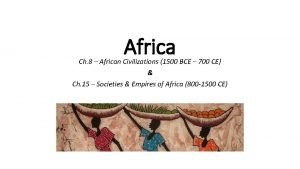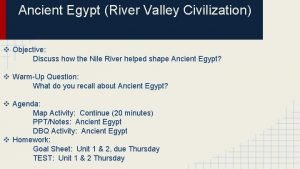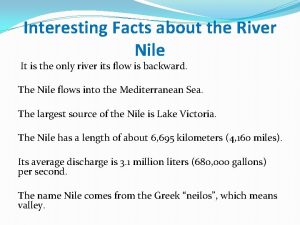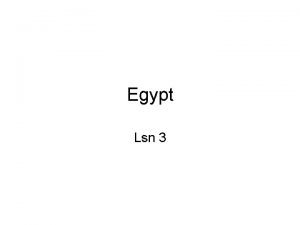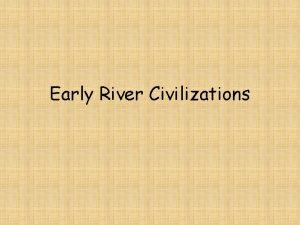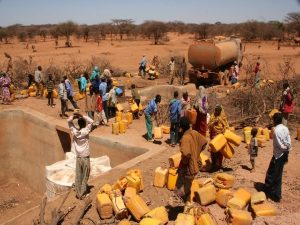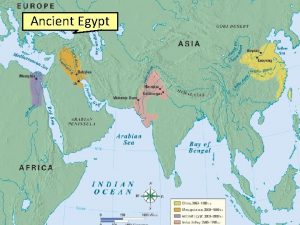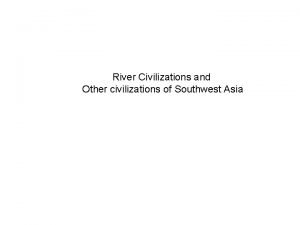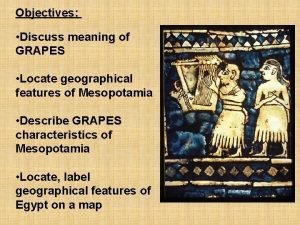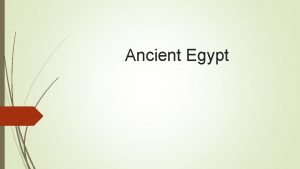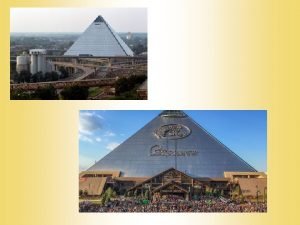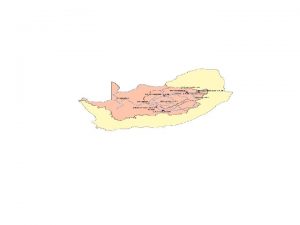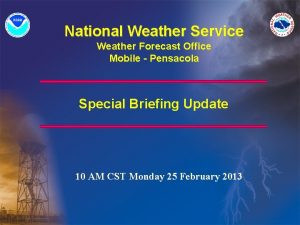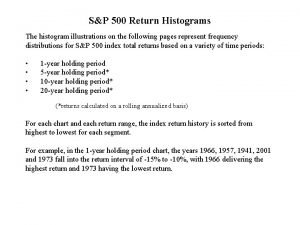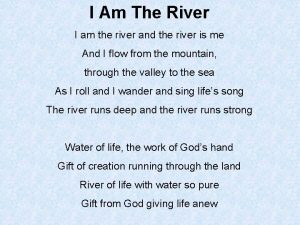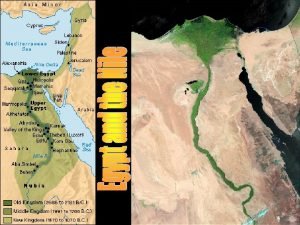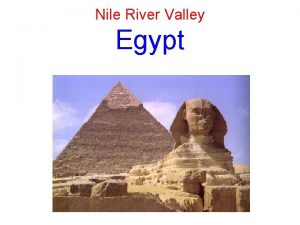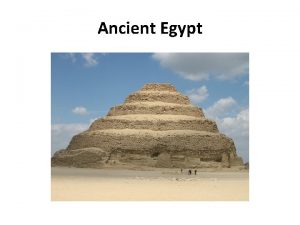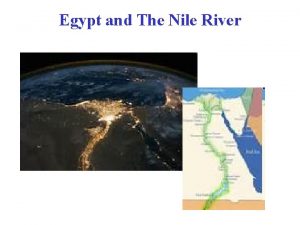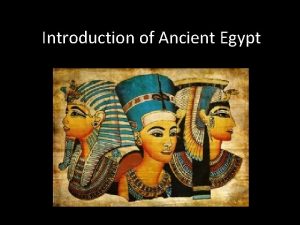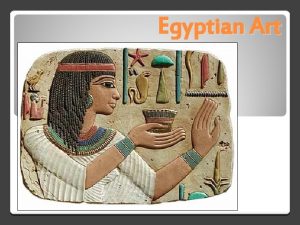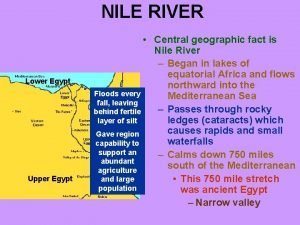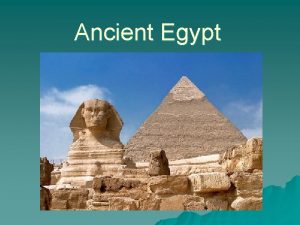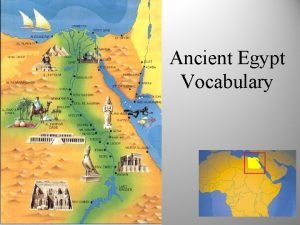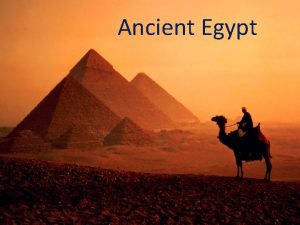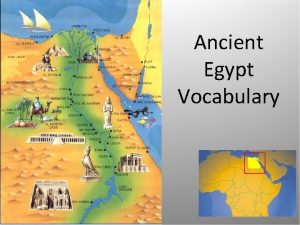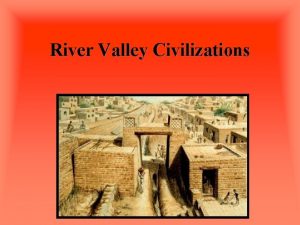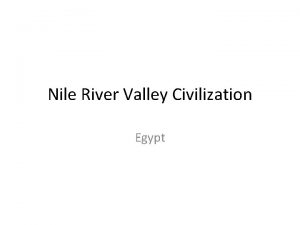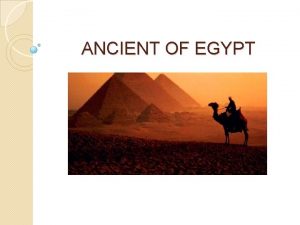Egypt The setting River Nile Regular yearly flood
































- Slides: 32

Egypt The setting • River Nile • Regular yearly flood of 4 months, with the water beginning to rise around the June solstice, for three months. (noted by Herodote (born 484 BC) • Irrigation systems.


3

Time line Assume we are in the reign of Tutankhamun (actual 1330 BC) Assume it is now in year 2017 NOW Great pyramid 700 Tut. 2017 Julius Caesar Moon landing 3500 5500

Summary of history Old Kingdom (2700 -2150) pyramids (1 -6) First intermediary period (IP). (2150 -2050): disorders Middle Kingdom (2050 -1650) (11 -14) Second IP (1650 -1550): disorders New Kingdom (1550 -1050): Tut, Ramses (18 -20) Third IP (1050 -700): disorders Late period (700 -332) Macedonian, then Ptolemaic period (332 -30 )

Documents • Old and Middle Kingdom – Inscriptions, indirect evidence • New Kingdom – Direct evidence • Yields higher than in the rest of the world • Ptolemies (after Alexander’s conquest, 332 BC) • Survival of documents skewed in different manners • Survival of 0. 0001% of written documents (Posener’s estimate) • Number of Ptolemaic to Arabic doc, 1 – 1. 5 million

Geography matters • Egypt provides a unique physical, archaeological, and historical record of environment, technology, land use, settlement, and economic history. • In effect, the Nile constitutes an oasis corridor through a thinly inhabited desert, providing a test tube case for a society circumscribed by its environment and relatively isolated from external turmoil. Karl Butzer

Recall: Mesopotamia (Irak) : Two rivers (Euphrates and Tigris), large basin of irrigation. Cities can radiate, grow and interact. Egypt: Narrow valley (except for Delta). Does support cities of significant size (transportation cost). Cities are centers of administration (Brazilia, Abuja, Yamoussoukro).

Protection from the outside • Peasant society • Low population compared to the agricultural output • Yields higher than in the rest of the world • (more than 10, twice Europe’s rate in 15 th century) • Taxable surplus went more into public projects rather than military expenditures

Irrigation Decentralized system • very powerful river • irrigation upstream has no impact downstream • no need for centralization, but: – local coordination and advice – overall evaluation of the flood for crop prediction and taxation • Wittfogel’s mechanism for despotism does not apply. 10


Basin irrigation • Flooding late June in Aswan, reached Cairo area late August • Natural, or recessional agriculture developed into a more controlled “artificial” system, split holdings as a risk strategy, and gardens • The artificial system probably began quite early. • Connection between canal digging for irrigation and for monumental building, i. e. pyramids in the Old Kingdom • The system largely locally organized, in response to shocks, population pressure, with the ruler coordinating by decree and sanction • Most basin land produced one crop per year, but some two. • Average wheat yield (1: 10) could be much higher with improvements in technology (works of the Ptolemies-after 300 BC, in the Fayum).

• State provides public goods • First public good : Law and order Account of a public official in Egypt around 2100 BC: Horus wanted me to restore order [in the nome of Edfu] since he had brought me in that nome to restore order. I found the district of Khuhu flooded as a ? ? , neglected by the one who had been in charge and ruined by a wretched person. I acted such that a man would embrace the murderer of his father or of his brother, with a view to reestablish order in the nome of Edfu. ''

Law and justice “Maat” signified concepts of “justice, order, truth” • The king was divine, born of a god. His word was law. Thus royal decrees set the law of the land. • Everyone had a right to petition the king for justice • Probably no written law codes as other places in the ancient Near East. • The Vizier was responsible for administration of justice. Two such officials in the New Kingdom.

Archaic Period Dynasties = families Manetho, ca. 270 BCE Dynasty 1 - 2 3150 -2686 BCE King Scorpion King Narmer Falcon god Horus Royal name Palace facade

( The Old Kingdom The Age of the Pyramids Dynasty 3 -6, ca. 26862181 BCE King Djoser--step pyramid at Sakkara First known wall, architect: Imotep Jean-Philippe Lauer (1902 -2001) (Read John Ray)

The “Intermediate” periods • After the Old, Middle and New Kingdoms • A decline of central state authority • Important, creative periods where there clearly were responses and adjustments • Were the intermediate periods related to flood regimes of the Nile?

The Hekanakhte letters • Middle Kingdom • Economic decisions of an individual • Household consumption/ budgets • Owned more than 70 arouras-providing for household, 23 ar. Leased out (one aroura=2700 m 2) one acre 4000 m 2 • Crops-cereal & flax for consumption, cloth, surplus barley for purchase of other items • 2 bad years (low Nile floods)-no income, hence the urgency of the letters • Note: half the Nile valley floodplain still used as unimproved pasture or fallow

19

The Middle Kingdom Dynasty 11 -13 2181 -1650 BCE • The Classic Age of Egyptian literature • Beginnings of imperial expansion south • the rise of Thebes (“middle Egypt”, near Luqsor) • The rise of a bureaucracy • Fayyum is first developed - first evidence of direct state involvement in expansion • A period of environmental stress (? )

The New Kingdom Dynasty 18 -20 1570 -1069 BCE Imperial Egypt, new technology Most famous pharaohs Queen Hatshepsut King Akhenaten (1351 -1334) Unique god: sun Nefertiti King Tutankhamun (~ 1332 -1323) King Ramses II (~ 1279 -1213)

Ptolemaic and Roman period 332 BCE-ca 323 CE • Conquest by Alexander • Macedonian and Roman domination • Very important for legacy • Rosetta Stone • Cleopatra

The Rosetta stone • found during the expedition of Bonaparte in Egypt (1798) provides the same text in three languages: hieroglyphs, demotic, and greek characters. deciphered in the early-19 th century. (Champollion and others) Like in other important official documents (e. g. Magna Carta) later in this course), taxes play a prominent rol

TEXT OF THE ROSETTA STONE (around 200 BC) In the reign of the young one who has succeeded his father in the kingship, lord of diadems, most glorious, who has established Egypt and is pious towards the gods, triumphant over his enemies, who has restored the civilized life of men, lord of the Thirty Years Festivals, even as Ptah the Great, a king like Ra, great king of the Upper and Lower countries, offspring of the Gods Philopatores, one whom Ptah has approved, to whom Ra has given victory, the living image of Amun, son of Ra, PTOLEMY, LIVING FOR EVER, BELOVED OF PTAH, in the ninth year, when Aetos son of Aetos was priest of Alexander, and the Gods Soteres, and the Gods Adelphoi, and the Gods Euergetai, and the Gods Philopatores and the God Epiphanes Eucharistos; Pyrrha daughter of Philinos being Athlophoros of Berenike Euergetis, Areia daughter of Diogenes being Kanephoros of Arsinoe Philadelphos; Irene daughter of Ptolemy being Priestess of Arsinoe Philopator; the fourth of the month of Xandikos, according to the Egyptians the 18 th Mekhir. DECREE. There being assembled the Chief Priests and Prophets and those who enter the inner shrine for the robing of the gods, and the Fan-bearers and the Sacred Scribes and all the other priests from the temples throughout the land who have come to meet the king at Memphis, for the feast of the assumption by PTOLEMY, THE EVER-LIVING, THE BELOVED OF PTAH, THE GOD EPIPHANES EUCHARISTOS, of the kingship in which he succeeded his father, they being assembled in the temple in Memphis on this day declared: Whereas King PTOLEMY, THE EVERLIVING, THE BELOVED OF PTAH, THE GOD EPIPHANES EUCHARISTOS, the son of King Ptolemy and Queen Arsinoe, the Gods Philopatores,

has been a benefactor both to the temple and to those who dwell in them, as well as all those who are his subjects, being a god sprung from a god and goddess like Horus the son of Isis and Osiris, who avenged his father Osiris, being benevolently disposed towards the gods, has dedicated to the temples revenues of money and corn and has undertaken much outlay to bring Egypt into prosperity, and to establish the temples, and has been generous with all his own means; and of the revenues and taxes levied in Egypt some he has wholly remitted and others has lightened, in order that the people and all the others might be in prosperity during his reign; whereas he has remitted the debts to the crown being many in number which they in Egypt and the rest of the kingdom owed; and whereas those who were in prison and those who were under accusation for a long time, he has freed of the charges against them; and whereas he has directed that the gods shall continue to enjoy the revenues of the temples and the yearly allowances given to them, both of corn and money, likewise also the revenue assigned to the gods from the vine land from gardens and the other properties which belonged to the gods in his father's time; and whereas he directed also, with regard to the priests, that they should pay no more as the tax for admission to the priesthood than what was appointed them throughout his father's reign and until the first year of his own reign; and has relieved the members of the priestly orders from the yearly journey to Alexandria; and

The bureaucracy • In Old Kingdom, largely tied to the royal family • Taxation, bureaucracy tied to monumental building • Rise of a “professional” bureaucracy by end of Old K. • Articulated in Middle Kingdom, and increased in New Kingdom • Centered on the nomes (about 20 districts), with royal appointment, but inherited • Unlike the Han, no recruitment/examination system as far as we know

Administration (Ptolemies and before) • Detailed census on the population, land ownership and productivity of each plot of land. • Nile is great setting for monitoring the agricultural output. • Since everything depended on the Nile, Egyptian kings kept track of the water level. Nilometer “When the corn began to ripen in Egypt, the fields were measured by two scribes, the `holder of the cord' and the `stretcher of the cord' and on the data obtained an assessment would be made of bushels or sacks of corn per unit of land”.

Civil servants and scribes • Scribes play a critical role • Problem of • controlling the scribes • controlling the controllers 28

Technology • Primitive mathematics to measure surface area (? ) • Storage of grain • Lifting of water (all used in modern times) • Shaduf (New Kingdom) • Saqiyah (Ptolemies) • Archimedian wheel 29

Money • Inscription near the sphinx (Khafre, around 2500): • I have purchased this house from the scribe Tjenti. I gave him 10 shats for it; one piece of cloth with four thread (? ), 3 shats; one bed, 4 shats; one piece of cloth with two threads (? ), 3 shats. • Money: unit of account – Not a store of value – Not much precious metal for money • Some copper rings ? – No trade for money – Would a despot allow money (underground economy) ? • Introduction of money by the Greeks (300 BC)

Main taxes • Direct and indirect taxes. • Direct: income • Indirect: consumption transactions • Corvée: (french term which has become part of the technical jargon) not a very efficient device, but useable when administration and trade sphere is underdeveloped. • Rates on income tax seems to have been high, about 20 percent. • In Mesopotamia lower around 10 percent but sometimes more up to 50 percent (clay tablets in Babylonia). • Additional revenues from the merchants (guilds). (1/3). • Payment in gold, silver, cattle, linen, goods in kind (fish)

Revenues structure under the Ptolemies issue of information and enforcement • Wheat: direct taxes – Administered by the state – Control of the seeds (high interest), and of the output • Indirect taxes: fruits and grapes: – special conditions of production, – triangle: individual, tax farmer, government official, self-control. • Historical importance of tax farming (until 18 th century) • Oil : Monopoly (state or regulated): later on the pizza…. • Import taxes (natural barriers) • Control of the economy – public projects (irrigation in the Fayum), guidances for crops, strict control for taxation. High tax rates (up to 50 percent of the output)
 What lasting legacies did the aksum kingdom leave
What lasting legacies did the aksum kingdom leave How did the nile shape ancient egypt essay
How did the nile shape ancient egypt essay How did the nile shape ancient egypt dbq answer key
How did the nile shape ancient egypt dbq answer key Egypt is the gift of the nile
Egypt is the gift of the nile Nile river map
Nile river map Interesting facts about the river nile
Interesting facts about the river nile Wheres the yellow river
Wheres the yellow river Kush nile river
Kush nile river Nile river basin
Nile river basin A section of the nile river with rapids and rocky terrain
A section of the nile river with rapids and rocky terrain River valley civilizations map
River valley civilizations map What does the picture tell us
What does the picture tell us River nile is called the lifeline of
River nile is called the lifeline of Nile river
Nile river Relative location of cairo egypt
Relative location of cairo egypt Nile river
Nile river What is frontalism in egyptian art
What is frontalism in egyptian art Language egypt
Language egypt 6 cataracts of the nile river
6 cataracts of the nile river Ancient egypt advanced cities
Ancient egypt advanced cities Gary ridgway facts
Gary ridgway facts Nile river basin
Nile river basin Upper egypt and lower egypt
Upper egypt and lower egypt Vaal river flood
Vaal river flood Passaic river hydrograph little falls
Passaic river hydrograph little falls National weather service pensacola
National weather service pensacola Regular grammar generates regular language
Regular grammar generates regular language S&p 500 yearly returns
S&p 500 yearly returns Prince waste collection pays a yearly
Prince waste collection pays a yearly Green river (duwamish river tributary)
Green river (duwamish river tributary) I am the river and the river is me
I am the river and the river is me What is the theme of the bass the river and sheila mant
What is the theme of the bass the river and sheila mant Nile floodplain
Nile floodplain
